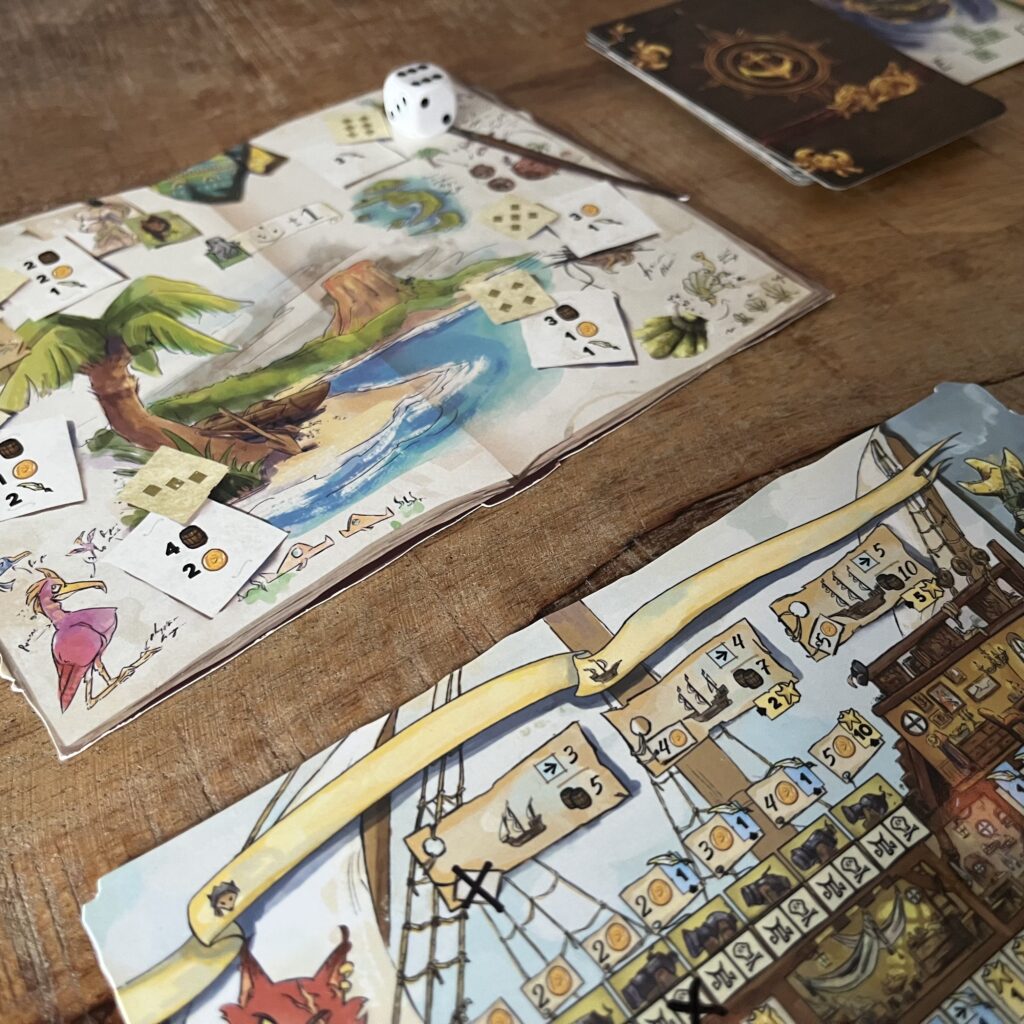What are the requirements to be a real pirate? If Hollywood is to be believed, pirates have an eye patch, a big hat, a wooden leg, crooked and yellow teeth or lack of teeth, scurvy, a taste for rum, a parrot and a beard. Unfortunately, I can only tick off one of the requirements: the beard. Fortunately, in Rolling Seas, a new game from Nuts! Publishing coming soon on Kickstarter, I can crawl into the leather boots and wooden leg of a pirate to experience some Caribbean calamities. After a game of Rolling Seas, I’ll be the best pirate you’ve ever seen. Yarrrrr landlubbers, we’re going to plunder the seven seas!
Background
Rolling Seas is a highly thematic roll/flip and write from Nuts! Publishing. You hear it right: flip and roll. In Rolling Seas you will not only roll multiple dice, but you will also flip cards. Based on the cards drawn, shapes will appear on your map, and based on the dice, you will start plotting routes and exploring. More on this later.

You may know Nuts! because of its more complex war games, but for quite some time Nuts! has been releasing a diverse range of different games. One of my favorite games from 2024 is the small-scale 4X game Diluvium: a very thematic, comprehensive but accessible game. With Rolling Seas, I had a similar experience as I had with Diluvium. Huge possibilities, a comprehensive and manageable game with a clear thematic twist!
Nuts! allowed me to try a prototype of Rolling Seas, together with Iris from CrimsonBoardgames. Iris preceded me and published a playthrough of her solo adventure in the wild waters of Rolling Seas. You can find her video here.
Setup and goal
At the beginning of Rolling Seas, each player receives a board with a ship (a kind of score sheet similar to other roll and writes) and a map (somewhat similar to the brilliant Cartographers). On their ship, players keep track of how strong their cannons are, how agile their ship is, how much provisions and gold they currently have, but more importantly, how many points their pirate stories are worth. Indeed, with these stories/legends, players can accumulate renown every time they visit a port, and the player with the most renown wins Rolling Seas. So players try to collect as many stories/legends as possible on their journey by having adventures and by exploring.


In addition to receiving these two player boards, each player also receives a compass to keep track of their wind direction. Players assemble a pile of adventures with different cards and are ready to play. When the pile of cards is empty, the game ends and the pirate with the most renown wins.
Gameplay
Each round proceeds in the same way. One of the players draws a card from the adventure pile, the dice are rolled and players may simultaneously perform one of the three available actions.
At the beginning of the round, a card from the adventure deck is revealed. There are smooth sailing cards and adventures. With a smooth sailing card, players cross off certain elements on their ship. They receive gold and/or provisions and/or pirates and/or sea monsters become stronger. With each adventure card, players must draw the shape depicted on their map. The map also indicates the “coordinates” to which this shape must be adjacent. There are several adventures that players can explore:
Sea monsters: players must discard provisions unless they have enough cannons. Players receive story points.
Pirates: players must discard a lot of provisions unless they have enough cannons to defeat the pirates. Players always receive story points, but if they win against a pirate they also receive additional bonuses.
Events: these are spaces you have to sail through, but you are not allowed to stay here. You receive story points if you sail through them.
Rocks: these areas block your sailing trip and are impassable. If you play Rolling Seas with multiple players, other players have to draw these rocks and can thus thwart you.
Currents: provide additional movement in a specific current, as well as story points.
Ambushes: these cards only appear in multiplayer mode. Players lay ambushes for each other.
After the card is dealt, four dice are rolled. Three winds and one exploration die. Players then perform one of three available actions:
Sailing: choose a wind direction and move your ship by spending movement points. You may discard provisions for an additional movement. Sailing in the chosen direction is cheaper than sailing against the chosen direction. With sailing you can experience different adventures and thus earn story points. Sailing also allows you to maneuver towards land and ports to explore in subsequent turns or to visit a port. Players draw a line to sail and always sail from their last point.
Explore: You can explore an adjacent piece of land and grab the bonuses indicated by the die on the central game board. By visiting ancient monoliths, there are more bonuses you can choose from and you can potentially collect story points and bonus points. Exploring also allows you to build cannons.
Port visits: by visiting a port you can score story points on the renown track (the actual points) and you can upgrade your ship, fill cargo hold with provisions and buy cannons.
Verdict
The end of the game is in itself when the adventure deck is empty. Then you score your story points one last time. I find the way of scoring points in Rolling Seas a very interesting mechanism and also very thematic. Namely, players go on adventures to collect stories and once they reach a port, they can tell these stories for renown. The more often players collect stories and the more often they enter a port, the greater their renown as pirates becomes.

The combination between a roll and write and a flip and write adds dynamism and variety. The adventures remind me somewhat of the mechanics of Cartographers in that players draw boxes with different areas on a map, but that’s where the comparison ends. Players try to plan a route and optimize points. The gameplay is also very thematic and the mechanism with the wind directions works intuitively. The gameplay is expansive, especially for a roll and write, but certainly manageable. As a result, it feels more like a large-scale board game than a simple dice game. The solo mode works very well, but the multiplayer mode is definitely interactive due to the rocks and ambushes, which does make players feel like they are really exploring the wild waters together.



